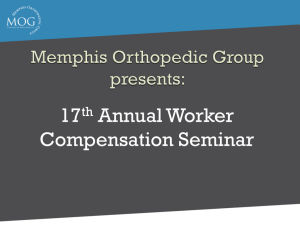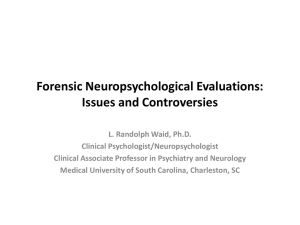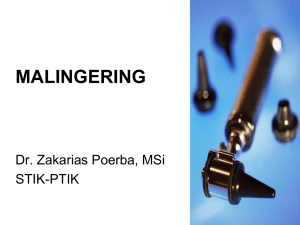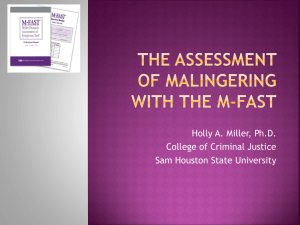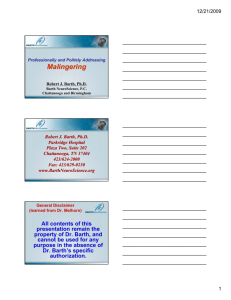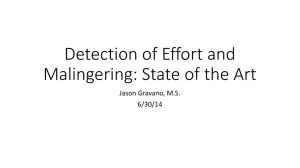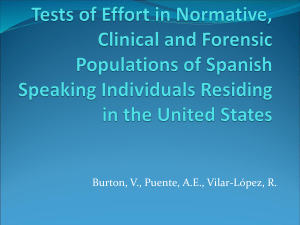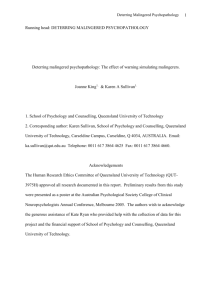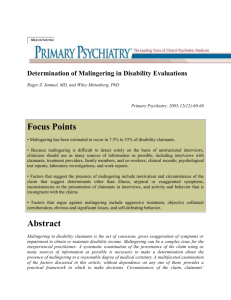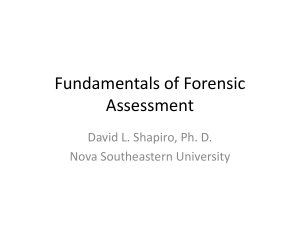Malingering - Rage University
advertisement
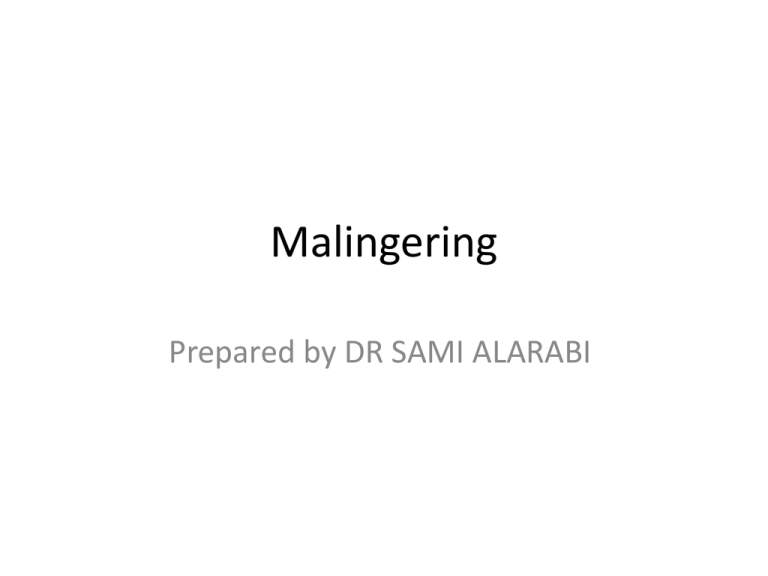
Malingering Prepared by DR SAMI ALARABI DEFINITION AND COMPARATIVE NOSOLOGY According to the revised fourth edition of the DSM (DSM-IV-TR):The essential feature of Malingering is the intentional production of false or grossly exaggerated physical or psychological symptoms, motivated by external incentives such as avoiding military duty, avoiding work, obtaining financial compensation, evading criminal prosecution, or obtaining drugs. Under some circumstances, malingering may represent adaptive behavior for example, feigning illness while a captive of the enemy during wartime. Malingering should be strongly suspected if any combination of the following is noted: (1) medicolegal context of presentation (e.g., the person is referred by an attorney to the clinician for examination or is incarcerated), (2) evident discrepancy between the individual's claimed stress or disability and the objective findings, (3) lack of cooperation during the diagnostic evaluation and in complying with the prescribed treatment regimen, (4) the presence of antisocial personality disorder. Definitions of Subtypes of Malingering It has been suggested that malingering be considered not as a dichotomous variable (a condition that is either present or absent), but as falling along a continuum in terms of (1) degree of intentionality, (2) degree of symptom exaggeration involved, and (3) degree of actual impairment (if any). In keeping with the concept of a continuum, the following definitions have been proposed: Pure malingering: Feigning a disease or disability when it does not exist to any extent. Partial malingering: Consciously exaggerating symptoms that really exist. False imputation: Ascribing actual symptoms to a cause consciously understood to have no relation to the symptoms. Misattribution: Ascribing actual symptoms to a cause erroneously believed to have given rise to them. Such misperception is often the product of unconscious processes that have interfered with reality testing, and, in its pure form, it does not constitute malingering. To the extent that the misattribution is consciously augmented (false imputation), malingering is at play. In addition to the various degrees of malingering, several forms of malingering have been identified and defined: Simulation: Feigning symptoms that do not exist or the gross, conscious exaggeration of preexisting symptoms. Simulation has sometimes been referred to as faking bad and positive malingering. Dissimulation: Concealing or minimizing existing symptoms. Dissimulation has also been called faking good, negative malingering, and defensiveness. The term is somewhat confusing because it has sometimes been used to refer to medical faking in general that is, as a synonym for malingering. Staged events: Carefully planning, orchestrating, and executing events, with the desired result being either an actual injury or a credible explanation for a disability that will later be feigned. Data tampering: Altering diagnostic data or records to simulate a disorder. Such alteration might take the form of self-mutilation (to influence the outcome of a physical examination), physical addition to or removal of substances from laboratory specimens (to influence the results of analyses performed on the specimens), or defacing or adjusting laboratory reports, diagnostic instruments, and medicohistoricolegal documents. Opportunistic malingering: Exploiting a naturally occurring event or preexisting medical condition for gain. Opportunistic malingering is distinguished from partial malingering, which involves the exaggeration of specific preexisting symptoms. Symptom invention: Falsely and consciously complaining of symptoms that are unrelated to any current or preexisting disorder or injury. DIAGNOSIS AND CLINICAL FEATURES In his 1823 Medical Jurisprudence, Beck described the three contexts that have most stimulated malingering behavior throughout history. Diseases are usually feigned from one of three causes fear, shame, or the hope of gain. Contemporary eight patterns of malingering however, these distinctions are less important than the common theme of symptom fabrication • Avoidance of Criminal Responsibility, Trial, and Punishment • Avoidance of Military Service or of Particularly Hazardous Duties • Financial Gain • Avoidance of Work, Social Responsibility, and Social Consequences • Facilitation of Transfer from Prison to Hospital • Admission to a Hospital • Drug-Seeking • Child Custody DETECTION OF MALINGERING • The clinician must rely initially on interviewing skills and history to detect malingering. Untrained observers seem to do little better than chance in lie detection, and some studies have found police detectives do hardly better than undergraduates in judging guilt versus innocence. Detecting Deception • Malingering is harder to maintain as the evaluative interview becomes increasingly lengthy, because of basic fatigue and a pull toward reality. Therefore, when malingering is suspected, the clinical interview should be long and detailed. Research on lying and malingering has shown that liars often speak in high-pitched voices, make errors of grammar, and make slips of the tongue • The clinician's suspicion should be aroused if an interviewee makes too many spontaneous assurances of veracity, such as Would I tell you a lie? or To be perfectly honest. Detection of Specific Malingered Conditions Malingered Mental Deficiency or Mental Retardation Clues to the Detection of Malingered Mental Deficiency or Mental Retardation 1. Striking discrepancy between level of education and level of intelligence 2. Striking discrepancy between military and employment records and presenting behavior and test performance 3. Striking discrepancy between adult test performance and prior pattern of test performance 4. Failure on easy items and success on difficult items during evaluative testing 5. Incongruity of vocational and social performance with presentation capabilities Malingered Cognitive Disorders • A noteworthy discrepancy reported between those who have dementia and those who are attempting to fake a cognitive disorder is the presence of marked perseveration in the former and its absence in the latter. Clues to the Detection of Malingered Cognitive Disorders 1. Lack of marked perseveration 2. Implausible symptom profile given reported injury 3. Psychotic symptoms confused with cognitive impairments 4. Unimpaired function in social and recreational realms in the face of gross disability Malingered Amnesia Amnesia, probably the most common clinical psychiatric presentation of malingering (except for malingered pain, which is not usually malingered in the homicide setting), is claimed by 30 to 35 percent of perpetrators of homicide. It is easy to feign and difficult to demonstrate. At least six possible causes have been suggested for amnesia: (1) conversion disorder, (2) psychosis, (3) alcoholism, (4) head injury, (5) epilepsy, and (6) malingering. A good diagnostic battery should include negative results on skull X-ray, head computed tomography (CT) or magnetic resonance imaging (MRI), and electroencephalography (EEG); normal findings on a neurological examination; a life history inconsistent with either conversion disorder or alcoholism (or other causes of intoxication); and a clinical examination and history inconsistent with either alcoholic amnesia (alcohol-induced persisting amnestic disorder) or alcoholic psychosis (alcohol-induced psychotic disorder). Clues to the Detection of Malingered Amnesia 1. No history of amnestic episodes 2. Antisocial personality traits more prominent than histrionic personality traits 3. Spotty, episode-specific amnesia rather than global amnesia 4. Recent, widely publicized, suspiciously familiar cases involving amnesia Malingered Psychosis In assessing an apparently psychotic patient, the clinician should obtain as much historical and collateral information as possible, especially if malingering is suspected. Motivation, availability of coaching, and adherence of the symptom picture to known disorder profiles are of use in assessing the plausibility of an evaluee's psychotic presentation. Features of Malingered Delusions 1. Abrupt onset and termination rather than gradual development and hesitant abandonment 2. Eagerness to call attention to delusions and symptoms rather than reluctance to acknowledge them 3. Behavior inconsistent with delusional content rather than reflective of delusional content 4. Thought content grossly disturbed in the face of conventional and goal-directed thought process Features of Malingered Auditory Hallucinations 1. 2. 3. 4. Continuous rather than intermittent Vague, inaudible, or unintelligible rather than distinct Free-standing rather than associated with delusions Stilted in language and specific in tone rather than basic and general 5. Reported in the first person rather than in the third person 6. Uncontrollable rather than susceptible to strategies for containment 7. Irresistible rather than susceptible to indifference Malingered Posttraumatic Symptoms Factors Suggesting Malingering of Psychological Distress after Trauma 1. Assertion of inability to work in the face of unimpaired capacity for pleasurable activity (recreation, social interaction) 2. Subscription to more obvious symptoms of widely publicized disorders in the face of denial of more subtle features 3. Spotty, questionable vocational history; tendency to drift; fringe member of society 4. Evasiveness during interview; unwillingness to concretely address a return to work, responsibility, and social expectation 5. General presentation of sullenness, suspicious guardedness, uncooperativeness, or resentment 6. Refusal to comply with recommended diagnostic or treatment procedures; avoidance of direct examination 7. History of disabling injuries and unusually frequent absences from work 8. Traits common to antisocial, narcissistic, borderline, or histrionic personality disorders 9. Energetic and concerted pursuit of legal claim in the face of alleged debility caused by depression and posttraumatic stress disorder 10. Refusal of employment suggested as plausible despite alleged disability 11. Self-depiction in excessively favorable and capable terms before alleged trauma and behavioral collapse Objective Testing Psychological testing has increasingly proven successful in the detection of malingering. By far, the most widely used psychological test for this purpose and the one with the broadest empirically validated data set, is the Minnesota Multiphasic Personality Inventory2 (MMPI-2). • Among the useful validity indicators is the gauge known as the F K scale, obtained by subtracting the K raw score from the F raw score. • Higher scores on the F K index suggest a greater likelihood that the subject is malingering overall. • With an F K index of +10, one would be correct approximately 97.5 percent of the time to assume that the entire MMPI-2 profile was malingered. Obviously, this is a significant indicator. • The F scale alone has been proposed as an indicator of malingering, particularly when the score approaches a t-score of 100 or above. • The F scale is composed of items endorsed by less than 10 percent of the population. Thus, scores on this scale can inform a clinician about the frequency to which odd, atypical items or symptoms are endorsed and, thus, the likelihood of an individual faking bad. Nonetheless, t-scores approximating 100 or above can signal not only an invalid profile due to malingering but also simple uncooperativeness, misunderstanding of the items, a plea for help from a patient who perceives the system as adversarial, or frank psychosis. The F validity scale itself has additional subscales that can also be useful indicators of malingering. The F(b), or the F-back scale, was designed to assess a fake bad mode of responding by containing additional items that have a low endorsement frequency (i.e., less than 10 percent of nonpatient adults). On this scale, evaluees should score roughly equivalent to the overall F score. Nevertheless, high T-scores on the F(b) indicate either generalized pathology or an attempt to exaggerate his or her level of symptomology. Similarly, the F(p), or F-psychopathology subscale, is yet another notable marker of malingering. This subscale is composed of subtle items that are rarely endorsed by nonpatients or those who have an obvious psychosis. Therefore, scores on the F(p) scale can be used as additional data to further evaluate a profile for faking bad. Scores on the K scale similarly tap into malingering, but at the opposite end of the continuum. Unlike the F scale, the K scale is composed of rather understated items related to difficulties that few individuals would deny. A significant score on the K scale, then, is a good measure of defensiveness and can identify individuals attempting to present themselves in a positive light. Higher scores on the K scale (a t-score of approximately 70 or above) suggest that either the patient is attempting to describe him- or herself in an overly favorable manner and denying difficulties or that he or she is nay-saying (answering false on all items). Finally, the variable response inconsistency (VRIN) and the true response inconsistency (TRIN) scales offer a further level of analysis of malingering potential. The VRIN scale is comprised of pairs of items that are similar or opposite in content. Thus, high scores on this scale suggest indiscriminate responding, which may be a result of malingering. Similarly, the TRIN scale is made up of pairs of items but only includes items that are opposite in content. Thus, a +1-point score would be generated on the TRIN scale for each opposite pair that the evaluee responded true to and a 1-point score would be generated for each opposite pair that the evaluee answered false to. Consequently, then, the TRIN is a good scale for detecting inconsistencies in responses related to answering true or false on all items. Besides the MMPI-2, other personality inventories can offer insight into an evaluee's propensity for malingering. A new and promising measure, known as the Personality Assessment Inventory (PAI), has fewer questions than the MMPI-2 but allows graduated answers, which avoids forcing an evaluee to answer only true or false. Other psychological tests provide a more focused exploration of a particular aspect of malingering. The Validity Indicator Profile (VIP) provides information about cognitive malingering. Most evaluees complete it in less than 1 hour; thus, like the PAI, it can be included as part of a single daylong assessment. The Structured Interview of Reported Symptoms (SIRS), developed by Richard Rogers, is an excellent instrument for assessing feigned psychosis. The Rorschach, although an excellent test, especially when scored with the published and validated Exner system, is not an appropriate instrument for making the diagnosis of malingering. DIFFERENTIAL DIAGNOSIS Factitious disorder, Ganser's syndrome, and somatoform disorders (especially conversion disorder) can be confused with malingering. Factitious disorder is distinguished from malingering by motivation (sick role versus tangible pain), whereas the somatoform disorders involve no conscious volition. In conversion disorder, as in malingering, objective signs cannot account for subjective experience, and differentiation between the two disorders can be difficult. Factors Aiding in the Differentiation between Malingering and Conversion Disorder 1. Malingerers more likely to be suspicious, uncooperative, aloof, and unfriendly; patients with conversion disorder likely to be friendly, cooperative, appealing, dependent, and clinging 2. Malingerers may try to avoid diagnostic evaluations and refuse recommended treatment; patients with conversion disorder likely to welcome evaluation and treatment, searching for an answer 3. Malingerers likely to refuse employment opportunities designed to circumvent their disability; patients with conversion disorder likely to accept such opportunities 4. Malingerers more likely to provide extremely detailed and exacting descriptions of events precipitating their illness; patients with conversion disorder more likely to report historical gaps, inaccuracies, and vagaries
